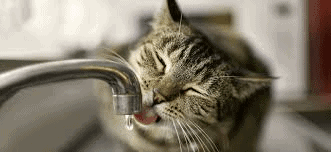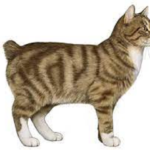Common Feline Bladder Stones Are Oxalate or Struvites. Today we focus on oxalate; tomorrow struvites
Discovering your Cat Has a Bladder Stone
Presumably you are reading this article because your cat has been diagnosed with a calcium oxalate bladder stone, or at least some kind of bladder stone, and you seek more information. Your cat almost certainly fits one of three scenarios: testing to pursue urinary discomfort led to the stone discovery, testing for an unresolving urinary tract infection led to the stone discovery, or the stone was found incidentally while looking for something else.
Cats with bladder stones tend to have the classical symptoms of feline lower urinary tract disease: straining to urinate, bloody urine, urinating in unusual places, genital licking. At some point in the course of testing to pursue these symptoms, a radiograph is taken and a stone or group of stones is seen in the urinary bladder. Alternatively, as mentioned, the cat might have a documented urinary tract infection, with or without symptoms. If urine cultures are still positive after a routine antibiotic course, it is prudent to look for a reason why. A bladder stone is a common explanation for failure to resolve infection so imaging (radiography or ultrasound) is recommended and the stone is discovered. Or the cat may have no symptoms whatsoever and the stones are discovered when radiographs are taken for some other reason.
In any case, here we are with one or more bladder stones in the cat’s bladder and we need to get rid of them and prevent their recurrence. Central to this mission is determining the type of stone, and while we may be able to get some information from the urinalysis, we really need to retrieve a stone for analysis to get the story. If we are lucky, the cat will pass a small stone that can be sent to the lab, but most likely we are going to need surgery or some kind of cystoscopy retrieval. Unlike struvite stones, calcium oxalate stones will not dissolve with dietary manipulation although an attempt can certainly be made at dietary dissolution. If this is unsuccessful, though, we are back to square one and the need to retrieve a stone.
Why do Cats Develop Calcium Oxalate Bladder Stones?
About 25 years or so ago, cats virtually never developed calcium oxalate bladder stones. Cat bladder stones could reliably be assumed to be made of struvite (a matrix of ammonium-magnesium-phosphate). In those days, feline lower urinary tract symptoms were generally thought to be caused by struvite crystals in urine and feline lower urinary tract symptoms were extremely common. The pet food industry responded by acidifying cat foods to prevent crystals from developing. In a way, it worked. Feline lower urinary tract symptoms declined. Male cats with struvite urinary blockages became far less common. The trade off was that calcium oxalate bladder stones began to develop. Acidifying the body leads to an acid urine pH and more calcium loss into the urine, both factors in the development of a calcium oxalate stone.
Currently most bladder stones formed by cats are calcium oxalate stones.
Calcium Oxalate Points
- Burmese and Himalayan cats appear genetically predisposed to the development of calcium oxalate bladder stones.
- Most calcium oxalate stones develop in cats between ages 5 and 14 years.
- 35% of cats with calcium oxalate bladder stones have elevated blood calcium (hypercalcemia).
- Cats with calcium oxalate stones tend not to have bladder infections and to have acid urine pH on their urinalysis.
- Obesity is a factor in calcium oxalate stone development.
How to get Rid of the Stones
Cystotomy (Surgical Removal)
The fastest way to resolve a bladder stone issue is to remove the stones surgically. To accomplish this, the cat is anesthetized and an incision made through the belly. The bladder is lifted into view, opened, and stones are removed. Cultures to rule out infection are obtained if not done previously. The bladder is closed in several layers. The belly is closed and the patient is awakened. Pain medication and antibiotics are routinely used after surgery. The patient usually remains hospitalized for a day or two to observe urination. The stones are sent to the lab for analysis. It is normal for some blood to be seen in the urine for several days after surgery.
USING DIET TO DISSOLVE A CALCIUM OXALATE STONE IS NOT POSSIBLE.
Once a stone has been retrieved, it can be submitted to the laboratory for analysis.
After it is confirmed as calcium oxalate, the goal is to prevent future stones.
Stone Prevention
Retrieving the stones is generally the easy part of managing calcium oxalate stones. Preventing future stones is more challenging. If the patient is one of the 35% with an elevated blood calcium, then steps to control the calcium level and determine why it is high should be taken. (See hypercalcemia). If blood calcium levels are normal, the following step by step regimen is recommended:
Step one: Feed a non-acidifying diet that minimizes calcium oxalates in urine
Such diets use a normal calcium content, a moderate magnesium content, and citrate to bind urinary calcium. Your veterinarian can recommend an appropriate therapeutic food.
Canned diet is preferred over dry food due to the high water content of canned foods. Part of the goal is to create a dilute urine and the extra water consumption is helpful. Meal feeding rather than free feeding also may be helpful in maintaining the desired urinary pH.
 Avoid supplementation with vitamin C (some food use it as a preservative; it’s also known asas ascorbic acid). Vitamin C is converted to oxalic acid, which modifies into oxalate. Be careful of pet vitamin supplements.
Avoid supplementation with vitamin C (some food use it as a preservative; it’s also known asas ascorbic acid). Vitamin C is converted to oxalic acid, which modifies into oxalate. Be careful of pet vitamin supplements.
In two to four weeks, perform a urinalysis to see if there are calcium oxalate crystals (there should not be), if the urine is dilute (the specific gravity of the urine should be less than 1.020), and if the urine pH is alkaline (it should be 6.8-7.5).
If the urinary pH is less than 6.5, the urine is too acidic and potassium citrate must be given as a supplement, either as a chewable tablet, capsule or oral liquid.Step two: Correcting problems in the first urinalysis
If the urine specific gravity is greater than 1.020, this means that the urine is not adequately diluted. The cat will need to drink more water. This is best accomplished by increasing the percentage of canned food in the diet. There is some controversy on what a cat’s specific gravity should be, and while a healthy cat should be capable of concentrating to s minimum of 1.035, for the purpose of diluting the urine to prevent stone formation, owners may used canned food or a veterinarian-prescribed diuretic.
Another urinalysis is performed in two to four weeks.
Step three: If oxalate crystals are present, the urine is not dilute, or if the pH of the urine is acid (pH less than 7.5) the following steps are taken:
A thiazide diuretic is added to dilute the urine and correct the necessary electrolyte balance in the urine. Vitamin B6 is supplemented. A population of cats has been identified for which a B-6 deficiency leads to oxalate stone development. This may or may not be helpful but is worth trying. The vitamin B-6 deficiency leads to an increase in blood oxalic acid, which in turn leads to an increase in urine oxalates. A different food may need to be selected.
Once a urinalysis with the appropriate values is obtained, the patient is rechecked every three to six months with a urinalysis and every six to 12 months for radiographs. In females, stones may be identified when they are still small enough to be induced to pass naturally. A male cat will require surgery to remove stones as the male tract is invariably too small for stones to pass.
Urban Animal Veterinary Hospital
1327 Yale St
Houston, TX 77008
(713) 863-0088


